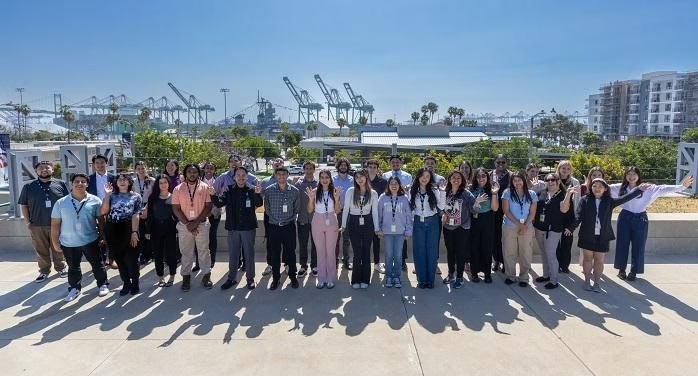By Mischa Geracoulis and avram anderson
https://www.projectcensored.org/meta-right-big-tech-project-2025-dei/
This is the second article in a two-part series. Read the first article, “Technogarchy Goes to Washington,” here.
When Mark Zuckerberg terminated Meta’s diversity, equity, and inclusion or DEI programs for hiring and training employees and procuring suppliers in January 2025, he forged “inroads with the incoming Trump administration,” abandoned Meta’s founding ethos of open innovation, and dramatically realigned how the tech giant will now do business, as critics like Bärí A. Williams, former lead counsel for Meta (then Facebook) and creator of its now-dissolved Supplier Diversity program, noted. Zuckerberg’s changes play right into the ultra-conservative presidential handbook, Project 2025, with potentially devastating consequences for the safety of numerous marginalized communities.
The supplier diversity program was meant to accomplish multiple goals, including creating economic opportunities for marginalized communities and mitigating gentrification caused by Facebook’s expanding headquarters into East Palo Alto’s Black and brown communities. However, by incentivizing its employees with $10,000 bonuses to move into East Palo Alto, Facebook increased traffic congestion and disproportionately drove up rents in the area. As a result, many of the city’s historic, working-class population faced evictions and other forced move-outs.
Then, in only a matter of weeks, Meta dismantled Facebook DEI programs that had taken years to build. Zuckerberg, of course, has the prerogative to change his company’s course. However, politically motivated decisions are often made during national swings of the partisan pendulum. In the inevitable event that the pendulum swings back in the opposite direction, Meta will find that its scrapped programs will be hard to recover. “The trust of users, employees, and suppliers has been destroyed,” said Williams.
Mirroring Meta’s change in corporate policies, the Chan Zuckerberg Initiative announced that they are ending both internal and external DEI efforts, work on immigration reform, and racial equity grantmaking, citing the “shifting regulatory and legal landscape.” In a recent survey, many leaders in corporate philanthropy indicated that they plan to reduce emphasis on racial equality (24%) and gender equality (22%) efforts in response to the trend, reflecting “a broader recalibration of corporate diversity strategies amid heightened scrutiny and pushback” that is being driven by “political polarization, legislative actions targeting diversity programs and race- or gender-specific philanthropic efforts, and intensifying stakeholder debates over the role of corporations in addressing social issues.”
The FCC goes full MAGA
Accusations from conservatives that their online content had been unfairly targeted for political reasons presumably factored into Zuckerberg’s decision to do away with fact-checking and other changes to Meta’s approach to content moderation. Studies have shown, however, that although posts by conservatives had, indeed, been taken down more frequently, this was not due to political beliefs. Rather, take-downs were spurred by the promotion of false claims, sharing of links to low-quality news sources, and the posting of hateful speech and imagery that violated community standards. FCC Commissioner and Trump’s chief censor, Brendan Carr, the author of Project 2025’s chapter on the FCC, would have the public believe that social media moderation practices infringe on First Amendment rights, as he asserted in a November 2024 letter to the Big Tech companies. Unless the government was explicitly involved in those takedowns, however, the decisions of private corporations have no First Amendment implications.
Meta’s overhaul of its fact-checking, content moderation, and DEI policies appears to have been motivated by the desire to proactively align itself with Trump administration ideology. Former Facebook employees who served on Meta’s DEI and trust and safety teams say this shift was “a long time in the making.” In 2024, for example, Sheryl Sandberg stepped down from Meta’s board of directors, to be replaced by the CEO of the Ultimate Fighting Championship organization, Dana White, “who leads the MAGA movements’ ultra-masculine sports league,” illustrating one of the steps that led to Meta’s current right turn.
In May 2024, Meta hired Dustin Carmack, former Heritage Foundation fellow and author of Project 2025’s Intelligence Community chapter, to assist with the development of Meta’s new approach to content moderation across all of its platforms, effectively intertwining Project 2025’s governmental priorities with Meta’s corporate policies and goals. Carr’s letter to Zuckerberg, Sundar Pichai of Alphabet (which owns Google), Tim Cook of Apple, and Satya Nandella of Microsoft (but not Musk) referred to them and their fact-checking, content moderation, and DEI practices as a “censorship cartel” that infringes on Americans’ right to free speech. In February 2025, Carr also issued a letter to Comcast, accusing the corporation of using DEI initiatives to impose discrimination (ostensibly against White people).
Trump delivers on Project 2025
The Global Project for Hate and Extremism (GPAHE) has warned that Meta’s new policies “align directly with Project 2025’s blueprint for dismantling” what Project 2025 identifies as “government censorship infrastructure.” Project 2025 perpetuates a manufactured moral panic around the assertion—unsupported by evidence—that “anti-white racism” is among the biggest threats to civil rights. The right-wing presidential playbook promotes White Christian Nationalism and involves plans to end the use of terms that allegedly “deprive Americans of their First Amendment rights,” including language for gender equality, gender equity, gender awareness, gender-sensitive, abortion, reproductive health, and reproductive rights, GPAHE reported.
Even though Trump said throughout the campaign season that he knew nothing about Project 2025, on January 20, 2025, he signed an executive gender order declaring there are only two sexes—defined biologically as male and female, following Project 2025’s plans to end the “DEI apparatus.” The executive order requires the federal government to use the term “sex” instead of “gender,” and will be reflected in all government-issued identification and other federal documents. The White House has also issued a ban on the use of pronouns in federal employees’ email signatures and on team communication platforms like Slack.
In response to guidance issued by the Office of Personnel Management, the Centers for Disease Control or CDC ordered researchers and scientists to pause or remove the publication of research with any of the following forbidden terms, “gender, transgender, pregnant person, pregnant people, LGBT, transsexual, non-binary, nonbinary, assigned male at birth, assigned female at birth, biologically male, biologically female,” creating challenges to “publish research on diseases that disproportionately impact groups who can no longer be named.”
Macho fashions for the autocrats
Trump’s gender order coincides with Silicon Valley’s “macho makeover,” with Zuckerberg and his tech bros Musk and Bezos “dressing like titans, strongmen, and emperors.” As Zuckerberg told podcaster Joe Rogan, “A culture that celebrates the aggression a bit more has its own merits,” provoking accusations of toxic masculinity.
Typically understood to encompass how men are “culturally trained and socially pressured to behave,” toxic masculinity is typically characterized by toughness, anti-femininity, and power. Zuckerberg’s endorsement of aggression “sends an even stronger message that women aren’t welcome,” wrote Ashley Morgan, a masculinities scholar at Cardiff Metropolitan University. The same point holds for nonbinary individuals, who might well wonder where they fit into Zuckerberg’s hypermasculine worldview.
The technogarchy “have long been aligning themselves with mythmaking, macho masculinity narratives,” and their new fashion aesthetic is not simply a trend, reported Amy Francombe, but a warning of “the consolidation of power in the tech industry” and its increased collaboration with the US government. “Zuckerberg’s style shift says something about a specific group of American billionaires who are aligning themselves with what looks to be a new political order within the United States,” Benjamin Wild of the Manchester Fashion Institute told Wired.
In Trump’s second reign—indeed, Trump fancies himself a king—replete with displays of strong-man entitlement, wealth, and misogyny, the masculinization of Big Tech also signals a normalization of patriarchal power; that is, men’s power over and exclusion of women and gender nonconforming persons throughout sociopolitical and economic systems built by men. Wild described “parallels with medieval royal courts, where members of the aristocracy competed among themselves, often in what they wore and how they consumed, for the attention and patronage of the ruler.”
Policies for safety obliterated
The purpose of hate speech policies is to keep all users safe, not to “put a target on the backs of one historically marginalized group,” said Jenni Olson, Senior Director of the Social Media Safety program at GLAAD. According to 404 Media interviews with five current Meta employees, many employees are furious over the company’s content moderation changes that now allow users on its platforms to say that LGBTQ people are “abnormal” and “mentally ill.” This, explained Olson, is anti-LGBTQ dog whistle language. Meta’s extreme-right posturing mirrors the deluge of anti-trans and anti-DEI efforts emanating from the Trump White House, and the new policies and changes “send a clear message that the tech giant and its leadership may actually hold (and espouse) bigoted, homophobic, and transphobic beliefs about LGBTQ people,” Olson warned.
Proponents of the DOGE takedown of DEI espouse a return to an allegedly merit-based society, but they ignore the fact that permitting, or even encouraging, hateful rhetoric on social media platforms can increase the likelihood of real world consequences, including threats and physical violence against members of marginalized communities. Meta may argue that the hateful rhetoric online doesn’t meet the criteria for hate speech established in Brandenburg v. Ohio (1969). Still, continual exposure to hateful ideas and language has been shown to result in acts of “stochastic terrorism,” the term used by scholars and law enforcement to describe how “ideologically driven hate speech increases the likelihood that people will violently and unpredictably attack the targets of vicious claims.”
Although stochastic terrorism is statistically predictable, when such acts of violence will occur and who will carry them out are not. For example, social media accounts such as Libs of TikTok and others spread virulent messages about the LGBTQ community that have led to bomb threats against Planet Fitness, public schools, libraries, and the firebombing of a progressive church in Plano, Texas.
Banned education, manufactured ignorance
The United States population is widely uneducated when it comes to LGBTQ culture, history, rights, and issues, particularly with regard to the transgender community.
Either because LGBTQ subject matter is not taught, or is banned outright, in US classrooms, the formation of opinions on the LGBTQ community is disproportionately shaped by transphobic content on social media. A void of factual information about the transgender community will likely be exacerbated by Meta’s changes, which will promote increased circulation of disinformation and misinformation on its platforms, including Facebook, Instagram, and WhatsApp. The trajectory of hate speech on X, after it was acquired by Musk and remodeled to reflect his distorted conception of “free speech,” provides a cautionary example. As with X, Meta’s new policies will promote astounding increases in racist, homophobic, Islamaphobic, antisemitic, and misogynistic speech on Meta platforms.
Pushback and boycotts
Although the number of companies abandoning DEI policies is growing, according to Fortune reporter Alena Botros, some prominent corporations, including Goldman Sachs, JPMorgan Chase, Costco, Salesforce, Apple, and Microsoft, are maintaining their diversity policies. Even the NFL has doubled-down on its commitment to DEI. And some employees at Meta are subtly pushing back “against their billionaire Big Tech boss,” Botros reported, by undertaking actions such as bringing tampons into the men’s restrooms at Meta.
Similarly, a movement is forming that encourages Tesla owners to get rid of their vehicles in protest of the Trump administration’s Department of Government Efficiency (DOGE), and “the wholesale incursions into government systems” by its de facto leader, Elon Musk. For example, singer Sheryl Crow got rid of her Tesla and donated the money to NPR, the public radio outlet that, Crow posted on X, is under threat by the Trump Administration. As per Project 2025’s promises and Trump’s executive order, PBS has shuttered its DEI office; and although NPR has a dedicated DEI office too, it has not yet announced its plans. PBS and NPR haven’t escaped Carr’s letters—the one to them claims that the public media outlets were in violation of their noncommercial status by publicizing their sponsors.
On February 19, 2025, Pew Research published findings from a survey of Americans’ opinions of Musk and Zuckerberg. The gist is that more Republicans view Musk favorably than Democrats; and views of Zuckerberg are mostly unfavorable among both parties. Polls from the first months of 2025 show that Trump’s approval ratings are slipping, mainly owing to his overreach of executive power. With consumer confidence plunging, some Trump supporters may be regretting their choice.
These findings may align with Bärí Williams’s advice “not to reward Meta with our engagement, our data, or their ability to earn ad revenue from us.” Invoking the history of the Civil Rights Movement, in which DEI has its roots, Williams described how boycotts were used to create safe spaces and entrepreneurial opportunities for marginalized communities. In her view, disengagement from Meta is the only way that Meta will feel the full consequences of the decision to abandon diversity. Author Caroline Sumlin wrote that, thanks to the earlier generation of civil rights activists who pressed on in the face of adversity, we should do the same now—not only for the present day but for future generations.
The dismantling of DEI practices, fact-checking, and loosening of content moderation around hateful speech is in direct conflict with the UN Guiding Principles on Business and Human Rights. Having pledged support for these principles, Meta continues to be responsible for respecting and protecting fundamental human rights even if doing so is not required by national law. Meta’s policy changes infringe on the human rights of others by actively encouraging discrimination across their platforms, refusing to address human rights linked to misinformation, and using “free speech” as rationale for human rights abuses.
When a handful of major tech companies have a monopoly on the information space, they can effectively control the content we consume, make top-down determinations about what is deemed morally acceptable or historically accurate, and decide what information and viewpoints to preserve, omit, or alter. This can lead to a version of reality that reflects and promotes narrow corporate interests at the expense of the public good.
To counter the twin threats of online hate speech and historical revisionism, users of these services should: develop an understanding of how information can be curated online through the use of algorithms that favor certain viewpoints over others; actively seek out information from a range of sources such as independent news, local media, and international outlets; and push for stronger regulations to ensure transparency and accountability in the digital space.















RPV Land Movement Community Update
RPV City Council Meeting
On March 18, Rancho Palos Verdes city council will receive an update on the landslide emergency, the latest land movement data, and the city’s remediation efforts.
The council will also consider allocating an additional $710,000 needed for repairs to the Abalone Cove Sanitary Sewer System, which serves the Portuguese Bend community association neighborhood. The city anticipated spending up to $3 million for repairs this fiscal year, but due to damage from ongoing land movement, another $710,000 is needed through the end of June 2025. Without this funding, certain parts of the system would need to be closed to prevent sewer spills, and additional homes would be red-tagged until they could use the sewer system again.
Finally, the council will consider extending by 60 days the local emergency declarations in the landslide area and the temporary prohibition of bicycles, motorcycles, and other similar wheeled vehicles from an approximately two-mile stretch of Palos Verdes Drive South.
A staff report (PDF) with more information is available on the City website.
Meeting Info
Time: 7 p.m., March 18
Details: Watch live on RPVtv’s YouTube channel, at rpvca.gov, or on Cox 33/FiOS 38. To participate in public comment during the meeting, fill out a speaker slip if you are attending in person, or complete a form online at rpvca.gov/participate to participate virtually or leave a pre-recorded voice message. Email your comments on this topic to cc@rpvca.gov
Venue: Zoom and at Hesse Park in McTaggart Hall.29301 Hawthorne Blvd, Rancho Palos Verdes